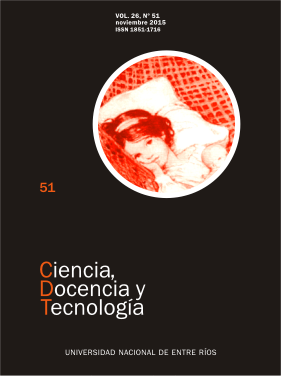Split between Teaching and Research? The Case of University of Buenos Aires
Keywords:
Changes in Higher Education, Scientific Research Policy, Teaching and Research, Buenos Aires UniversityAbstract
This article aims to provide elements for the analysis of the tendency to split up teaching and research in the current University. To this end, first it summarizes Levin (1997 and 2010) approach of intrinsic differentiation of capital in order to contextualize University’s recent transformations. Then, a first approximation is made to an analytical fiction of today’s University entitled University of Technological Capital (UCT). From this ideal model, the paper explores one of its features, the deeper split between teaching and research at the University of Buenos Aires (UBA). This is done by using the university statistical yearbooks and the UBA census for the year 2011, published recently. Finally, we conclude that the split between teaching and research at the UBA corresponds to the fiction of UCT.
Downloads
References
ALBORNOZ, M. (2002). Situación de la Ciencia y la Tecnología en las Américas. Disponible en: http://www.centroredes.org.ar/files/documentos/Doc.Nro3.pdf [19 de Enero de 2014].
BEKERMAN, F. (2010). Modernización conservadora: la investigación científica durante el último gobierno militar en Argentina (pp. 198-220). En: BEIGEL, M.F. (comp.). Autonomía y dependencia académica. Universidad e investigación científica en un circuito periférico: Chile y Argentina (1950-1980). Buenos Aires: Biblos.
BERMAN, E. (2012). Creating the Market University. Estados Unidos: Princeton University Press.
BOCKSTAELE, P. (2004). The Mathematical and the Exact Sciences. (pp:493-518). En: RÜEGG, W. (comp.). A History of the University in Europe. Volume III: Universities in the Nineteenth and early Twentieth Centuries (1800-1945). Epub: Cambridge University Press.
BOK, D. (2003). Universities in the Marketplace, Estados Unidos: Princeton University Press.
BUCHBINDER, P. (2005). Historia de las Universidades Argentinas. Buenos Aires: Editorial Sudamericana.
BUCHBINDER, P.; MARQUINA, M. (2008). Masividad, Heterogeneidad y Fragmentación. El sistema universitario argentino 1983-2008. Argentina: Biblioteca Nacional y Universidad Nacional General Sarmiento.
BRUNNER, J. (2012), La idea de universidad en tiempos de masificación, en: Revista Iberoamericana de Educación Superior (ries), III (7):130-143.
CHAPARRO, (2011). Universidad, creación de conocimiento, innovación y desarrollo. (pp.43-68). En: ALBORNOZ, M. y LÓPEZ CEREZO, J. (eds.). Ciencia, tecnología y universidad en Iberoamérica. Buenos Aires: Eudeba y Organización de Estados Americanos.
CHARLE, C. (2004). Patterns. (pp.33-80). En: RÜEGG, W. (comp.). A History of the University in Europe. Volume III: Universities in the Nineteenth and early Twentieth Centuries (1800-1945). Epub: Cambridge University Press.
CLARK, B. (2004). Sustaining Change in Universities. Open University Press. United Kingdom.
CONICET (2014). Resolución 2249. Disponible en: http://www.caicyt-conicet.gov.ar/wp-content/uploads/2014/07/CCSH_-RD-20140625-2249.pdf [15 de enero de 2015]
ESTATUTO UNIVERSITARIO DE LA UNIVERSIDAD DE BUENOS AIRES (1960). Disponible en: www.uba.ar/download/institucional/uba/9-32.pdf
ESPACIO EUROPEO DE EDUCACIÓN SUPERIOR (1999). Declaración de Bolonia. Disponible en: www.eees.umh.es [24 de abril de 2014].
ETZKOWITZ, H. (2008). The Triple Helix. University–Industry–Government Innovation in Action. Nueva York: Routledge.
ETZKOWITZ, H.; LEYDESDORFF, L. (2000). The Dynamics of Innovation: From National Systems and ‘Mode 2’ to a Triple Helix of University–Industry–Government Relations, en: Research Policy, 29:109–123.
FERNÁNDEZ DE LUCIO, I., CASTRO MARTÍNEZ, E., CONESA CEGARRA, F.; GUTIÉRREZ GRACIA, A. (2000). Las relaciones universidad-empresa: entre la transferencia de resultados y el aprendizaje regional, en: Revista Espacios, 21 (2):127-147.
FILMUS, D. (1990). La crisis de la educación universitaria latinoamericana: breves comentarios sobre el debate actual. Argentina: FLACSO.
FINKENSTAEDT, T. (2011). Teachers. En: RÜEGG, W. (ed.) A History of the University in Europe. Volume IV: Universities since 1945. Epub: Cambridge University Press.
FREEMAN, C. (1987). Technology Policy and Economic Performance: Lessons from Japan. Londres: Pinter.
GARCÍA DE FANELLI, A. (2008). Los instrumentos de la política universitaria: aseguramiento de la calidad y financiamiento, en: Educación Superior y Sociedad, 1:103-114.
GARCÍA DE FANELLI, A. (2007). The Challenge of Building Research Universities in Middle-Income Countries: The Case of the University of Buenos Aires. (pp.260-285). En: ALTBACH, P. y BALÁN J. (eds.). World Class Worldwide Transforming Research Universities in Asia and Latin America. Baltimore: Johns Hopkins University Press.
GARCÍA DE FANELLI, A. (1994). Universidad Nacional y sector productivo en Argentina. En: COSTA MOROSINI, M. (ed.). Universidades no MERCOSUR. San Pablo: Cortez.
GIBBONS, M. (1998). Pertinencia de la educación superior en el siglo XXI. Disponible en: http://www.humanas.unal.edu.co/contextoedu/docs_sesiones/gibbons_victor_manuel.pdf [12 de Julio de 2013].
GIBBONS, M.; LIMOGES, C; NOWOTNY, H.; SCHWARTZMAN, S.; SCOTT, P.; TROW, M. (1994). The New Production of Knowledge: The Dynamics of Science and Research in Contemporary Societies. Londres: Sage Publications.
GIRBAL-BLACHA, N. (2011). Organización y gobernanza de la ciencia y tecnología. (pp. 197-212). En: ALBORNOZ, M. y LÓPEZ CEREZO, J. (eds.). Ciencia, tecnología y universidad en Iberoamérica. Buenos Aires: Eudeba y Organización de Estados Americanos.
GROISMAN, F.; GARCÍA DE FANELLI, A. M. (2009). Incentivos a la profesión académica: los salarios de los docentes universitarios en la Argentina, en: Revista Latinoamericana de Estudios del Trabajo (RELET), 14(21):143-167.
GUAGNINI, A. (2004). Technology. (pp:593-635). En: RÜEGG, W. (comp.). A History of the University in Europe. Volume III: Universities in the Nineteenth and early Twentieth Centuries (1800-1945). Epub: Cambridge University Press.
HALPERIN DONGHI, T. (2003[1962]). Historia de la Universidad de Buenos Aires. Buenos Aires: Eudeba.
HARARI, H. (2013). Fetichismo de la mercancía y reformas en la Universidad, en: VI Jornadas de Economía Crítica. Mendoza.
HARVIE, D. (2000). Alienation, class and enclosure in UK universities, en: Capital and Class, 24(2):103-132.
HUMBOLDT, W. ([1810]1943). Sobre la organización interna y externa de los establecimientos científicos superiores en Berlín. (pp. 165-175). En:
HUMBOLDT, W. Escritos Políticos. México: Fondo de Cultura Económica.
KANT, I. ([1784]2009). Contestación a la pregunta: ¿Qué es la Ilustración?. Madrid: Alianza.
KROTSCH, P. (1990). Organización, gobierno y evaluación universitaria. (pp:101-136). En: PUIGGRÓS, A. y KROTSCH, P. Universidad y evaluación. Estado del debate. Argentina: Ideas
LAVAL, C. ; VERGNE, F. ; CLÉMENT, P. ; DREUX, G. (2012). La nouvelle école capitaliste. Paris : la Découverte.
LEVÍN, P. (2014). La ‘Reforma del 18’, su teoría en el sombrero. (pp:5-16). En: Apuntes para el Metaplán. CEPLAD. UBA
LEVÍN, P. (2010). Esquema de la Ciencia Económica, en: Revista de Economía Política de Buenos Aires, 7/8:247-289.
LEVÍN, P. (2008). Corrientes subterráneas en el pensamiento latinoamericano, en: Economía UNAM, 14 (5):87-106.
LEVÍN, P. (1997). El Capital Tecnológico. Argentina: Catálogos.
LEVÍN, P. (1977). Circuitos de Innovación, en Revista Interamericana de Planificación, XX (44). Disponible en:http://www.revistaespacios.com/a81v01n01/81010120.html [27 de Marzo de 2013].
LLOMOVATTE, S. (2006). Para una crítica del modelo de la triple hélice: universidad, empresa y Estado (pp.21-42). En: LLOMOVATTE, S. (comp.) La vinculación universidad-empresa: miradas críticas desde la Universidad pública. Buenos Aires: Miño y Dávila.
LÓPEZ CEREZO, J. (1998). Ciencia, Tecnología y Sociedad: el estado de la cuestión en Europa y Estados Unidos, en: Revista Iberoamericana de Educación, 18:41-68.
LUNDVALL, B. (1992). National systems of innovation. Towards a theory of innovation and interactive learning. Inglaterra: Pinter Publishers.
MARX, K. (1973[1867]), El Capital. Crítica de la Economía Política (Tomo I). México: Fondo de Cultura Económica.
MARX, K. (1973[1894]). El Capital. Crítica de la economía política (Tomo III). México: Fondo de Cultura Económica.
MARTIN, B. e IRVINE, J. (1992). Government spending: trends in government spending on academia and related research. An international comparison, en Science and Public Policy, 19:311-319.
MOULIER-BOUTANG, Y. ([2007]2012). Cognitive capitalism. Cambridge, Reino Unido y Malden, Estados Unidos: Polity Press.
NAIDORF, J. (2006). Antecedentes de la vinculación Universidad-Empresa desde la perspectiva del cambio en la cultura académica (1955-1984). (pp.91-112). En: LLOMOVATTE, S (comp.). La vinculación universidad-empresa: miradas críticas desde la Universidad pública. Buenos Aires: Miño y Dávila.
NEFFA, J. (2000). Las innovaciones científicas y tecnológicas. Una introducción a su economía política, Buenos Aires: Lumen Humanitas.
NELSON, R. (1993). National Innovation Systems: A Comparative Analysis. Nueva York: Oxford University Press.
ORTEGA Y GASSET, J. (2007[1930]). Misión de la universidad. Madrid: Alianza Editorial.
PESTRE, D. (2005). Ciencia, Dinero y Política. Buenos Aires: Nueva Visión.
PLASTINO, A. (2008). La universidad: lugar de investigación científica y transferencia tecnológica, en: Educación Superior y Sociedad, 13 (1):63-72.
RICARDO, D. (1973). Principios de Economía Política y Tributación. México: Fondo de Cultura Económica.
ROTHBLATT, S. (2011). Curriculum, Students, Education. (pp.238-275). En: RÜEGG, W. (ed.) A History of the University in Europe. Volume IV: Universities since 1945. Epub: Cambridge University Press.
SANTOS, C. (2009). El patentamiento universitario como fenómeno específico de la universidad del capital tecnológico. Una lectura desde la Economía Política, Proyecto de Tesis. Quilmes: Universidad Nacional de Quilmes.
SLAUGHTER, S.; LESLIE, L. (1999). Academic Capitalism: Politics, Policies, and the Entrepreneurial University. Estados Unidos: Johns Hopkins University Press.
SMITH, A. (2012[1776]). Investigación sobre la Naturaleza y Causas de la Riqueza de las Naciones. México: Fondo de Cultura Económica.
SOTIRIS, P. (2014). University movements as laboratories of counter-hegemony, en: Journal for Critical Education Policy Studies, 12(1):1-21.
VACCAREZZA, L. (1998). Ciencia, tecnología y sociedad: el estado de la cuestión en América Latina, en: Revista Iberoamericana de educación, (18):13-40.
VARELA, G. (1997). Los patrones de vinculación Universidad-Empresa en Estados Unidos y Canadá y sus implicaciones para América Latina. En: CASAS, R. y LUNA, M. (coordS). Gobierno, academia y empresas en México: hacia una nueva configuración de relaciones. México: Plaza y Valdés, UNAM.
Fuentes utilizadas:
Anuarios de Estadísticas Universitarias. Disponibles en: http://portales.educacion.gov.ar/spu/investigacion-y-estadisticas/anuarios/ [10 de febrero de 2014].
Censos de Docentes y Estudiantes de la UBA. Disponibles en: http://www.uba.ar/institucional/contenidos.php?id=194 [3 de agosto de 2014].
CONICET: http://www.conicet.gov.ar/becarios/ y http://www.conicet.gov.ar/acerca-de-conicet-en-cifras/ [19 de junio de 2014]
RICyT: http://www.ricyt.org/indicadores [4 de mayo de 2014]
Downloads
Published
How to Cite
Issue
Section
License
The authors retain the copyright and grant the journal the right to be the first publication of the work, as well as licensing it under a Creative Commons Attribution License that allows others to share the work with an acknowledgment of the authorship of the work and publication initial in this magazine. All content is published under the Creative Commons 4.0 international license: Attribution-Non-Commercial-Share Alike.






